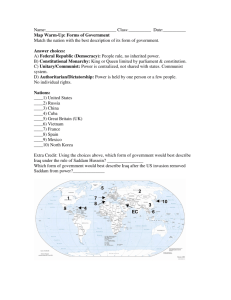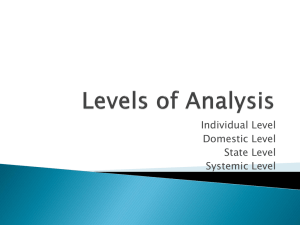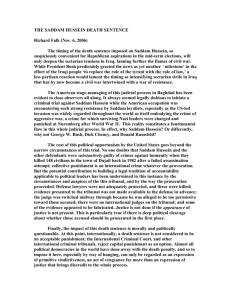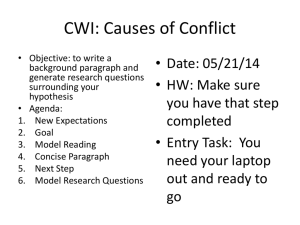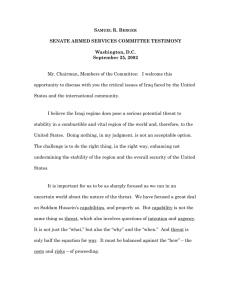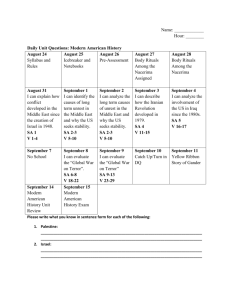S T FRANK J. GAFFNEY, JR.
advertisement
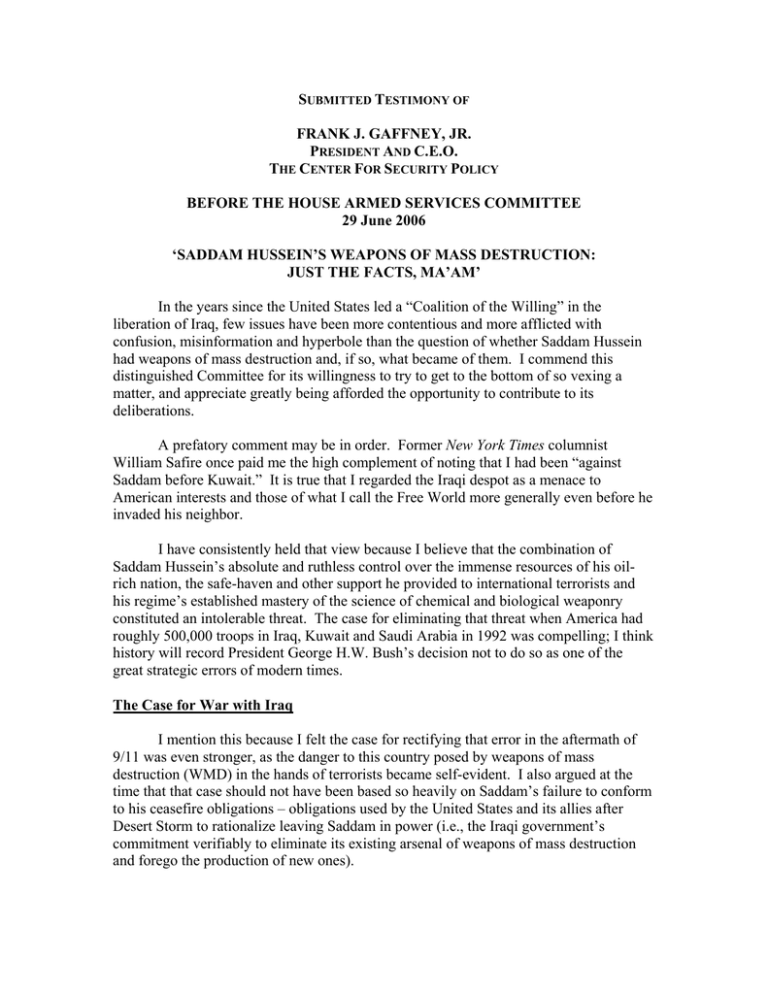
SUBMITTED TESTIMONY OF FRANK J. GAFFNEY, JR. PRESIDENT AND C.E.O. THE CENTER FOR SECURITY POLICY BEFORE THE HOUSE ARMED SERVICES COMMITTEE 29 June 2006 ‘SADDAM HUSSEIN’S WEAPONS OF MASS DESTRUCTION: JUST THE FACTS, MA’AM’ In the years since the United States led a “Coalition of the Willing” in the liberation of Iraq, few issues have been more contentious and more afflicted with confusion, misinformation and hyperbole than the question of whether Saddam Hussein had weapons of mass destruction and, if so, what became of them. I commend this distinguished Committee for its willingness to try to get to the bottom of so vexing a matter, and appreciate greatly being afforded the opportunity to contribute to its deliberations. A prefatory comment may be in order. Former New York Times columnist William Safire once paid me the high complement of noting that I had been “against Saddam before Kuwait.” It is true that I regarded the Iraqi despot as a menace to American interests and those of what I call the Free World more generally even before he invaded his neighbor. I have consistently held that view because I believe that the combination of Saddam Hussein’s absolute and ruthless control over the immense resources of his oilrich nation, the safe-haven and other support he provided to international terrorists and his regime’s established mastery of the science of chemical and biological weaponry constituted an intolerable threat. The case for eliminating that threat when America had roughly 500,000 troops in Iraq, Kuwait and Saudi Arabia in 1992 was compelling; I think history will record President George H.W. Bush’s decision not to do so as one of the great strategic errors of modern times. The Case for War with Iraq I mention this because I felt the case for rectifying that error in the aftermath of 9/11 was even stronger, as the danger to this country posed by weapons of mass destruction (WMD) in the hands of terrorists became self-evident. I also argued at the time that that case should not have been based so heavily on Saddam’s failure to conform to his ceasefire obligations – obligations used by the United States and its allies after Desert Storm to rationalize leaving Saddam in power (i.e., the Iraqi government’s commitment verifiably to eliminate its existing arsenal of weapons of mass destruction and forego the production of new ones). (One point that will be particularly relevant to my subsequent treatment of the new revelations about the discovery in Iraq of hundreds of “pre-Gulf War” chemical munitions is the fact that those were precisely the WMDs Saddam was supposed to destroy. He was not supposed to manufacture any others. Suggestions that we subsequently went to war only over different weapons, produced post-Gulf War, are erroneous and misleading.) President George W. Bush, nonetheless, was persuaded that the Iraqi regime’s sustained and confirmed violations of those ceasefire obligations would assure bipartisan support at home and offer the best chance for securing international support at the United Nations. This was not altogether unreasonable since Democratic and Republican administrations in Washington had determined Saddam was impermissibly retaining WMDs. For its part, the United Nations ultimately adopted some 17 resolutions documenting and denouncing the Iraqi despot’s non-compliance. In the event, although the Bush Administration sought congressional support for action against Iraq on several grounds, the threat posed by Saddam’s weapons of mass destruction (both those he had and those, including nuclear ones, he was believed to be seeking) became the preeminent justification for military action in the Fall of 2002. That was even more the case with the United Nations in the Spring of 2003. After all, the other principal arguments – i.e., that he was a brutal dictator and that he supported international terror – would have no standing at the UN. Plenty of the organization’s member nations are governed by regimes characterized by one or the other of these deplorable attributes, or both. An Incentive to Hide the Evidence I mention all this simply because the emphasis placed by the Bush Administration and by others on Saddam’s WMD program to justify toppling him from power created a powerful incentive for the Iraqi despot to destroy, relocate or conceal such weapons as part of his post-invasion strategy for defeating the Coalition. The Iraq Survey Group led initially by my colleague and friend, David Kay, has documented the catastrophic effect on its efforts to assess the true state of that program inflicted by “looters” and others who were able to expropriate or otherwise dispose of files, hard drives and evidence that would have shed light on Iraq’s weaponry of mass destruction activities and capabilities. It is worth mentioning in that connection one of the intercepts then-Secretary of State Colin Powell shared with the UN Security Council in his famous February 5, 2003 presentation of the U.S. case on Saddam’s non-compliance with the ceasefire terms and subsequent resolutions. In it, a commander is heard earnestly ordering a subordinate to clean up his facility lest its unspecified contents fall into hands unfriendly to the regime (most immediately weapons inspectors, but presumably invading troops, too).1 1 A transcript of this tape, as played during former Secretary of State Colin Powell’s presentation to the United Nations on 5 February 2003, can be found at http://www.cnn.com/2003/US/02/05/sprj.irq.powell.transcript.02/index.html. Surely, similar injunctions were given to personnel associated with the various WMD programs. Presumably, that fact – combined with the fear of retribution at the hands of regime loyalists or perhaps others – has contributed to the lack of cooperation we have received from such personnel in penetrating the secrecy associated with this priority activity. Finally, there is now a body of evidence that Saddam Hussein went to considerable lengths to move quantities of weapons of mass destruction from Iraq into Syria and Lebanon. A former Iraqi general, Georges Sada, has confirmed that he was charged with organizing an airlift for this purpose using the national airline’s civilian jets. Tape recordings recently – and outrageously belatedly – made public by the Director of National Intelligence, John Negroponte, have confirmed that the direction for air- and land-transport of WMDs was ordered at the highest levels of Saddam’s government in the run-up to the invasion. There have also been reports that Russian special forces and intelligence personnel assisted in the effort to eliminate evidence of Iraq’s WMD programs and Kremlin involvement in them. Just the Facts With all this as backdrop, let me offer several observations about Saddam Hussein’s weapons of mass destruction, the threat they posed and the implications of the latest revelations by the National Ground Intelligence Center about some 500 chemical munitions previously secured by U.S. forces. • First, it is undeniable that Saddam Hussein had chemical and biological weapons in the years before the liberation of Iraq. For one thing, he acknowledged as much. For another, he used some of these capabilities against Iranian forces and his own Kurdish population. He never accounted, as he was obliged to, for the destruction of that arsenal and it would be irresponsible to operate on any assumption other than that he continued to retain such capabilities. • Second, Saddam had the know-how, technology, trained personnel and facilities to manufacture chemical and biological agents at will. Having done so in the past meant that he could do so in the future. Even if, arguendo, he had eliminated every gram of chemical or biological agent and every munition in which it was or could be placed, producing more could be accomplished quickly. • Third, in a relatively little-noted finding, the Iraq Survey Group established that the Iraqi dictator was actually engaged in continuing, low-level research and development on and even production of chemical and biological agents such as sulfur mustard, nitrogen mustard, ricin and aflatoxin. He thus maintained not only the potential to generate small quantities of such toxic materials – say, the quantities suitable for terrorist or “intelligence” purposes. He actually was still in that business at or about the time of Operation Iraqi Freedom. • Fourth, the Iraq Survey Group also found that Saddam Hussein’s henchmen had plans to emplace sarin nerve gas and sulfur mustard in “perfume sprayers and medicine bottles which they would ship to the United States and Europe.” This, Mr. Chairman, is for me the sort of “smoking gun” we should have been looking for: Hard evidence that the so-called “Butcher of Baghdad” was, in fact, bent on unleashing terror attacks against this country and its allies as part of his pursuit of revenge against those who humiliated him in the first Gulf War. • Fifth, the Iraq Survey Group learned that “ricin [a deadly toxin] was being developed into stable liquid to deliver as an aerosol.” As one of the ISG’s inspectors, Richard Spertzel, observed in the Wall Street Journal last October: “Such development was not just for assassination. If Iraq was successful in developing an aerosolizable ricin, it made a significant step forward. The development had to be for terrorist delivery. Even on a small scale, this must be considered as a WMD.”2 • Sixth, Saddam’s regime actually tested its arsenal of WMD against human subjects. According to Mr. Spertzel, this may have continued as late as 2002. It is hard to square such ongoing and inhumane activity with any purpose other than the intent to confirm the ability to cause assured, and probably mass, destruction. The Latest Revelations So, against this backdrop, what are we to make of the finding that a large number of “pre-Gulf War” munitions apparently containing aging and degraded chemical agents have, in fact, been found by U.S. forces since the fall of Saddam’s regime? Given the foregoing facts, such a revelation should not come as a particular surprise. That is especially true insofar as Saddam’s military stashed innumerable ordnance caches all over the country and, evidently with some frequency, emplaced chemical weapons amidst conventional ones. As your colleagues, House Intelligence Committee Chairman Peter Hoekstra and Sen. Rick Santorum – who deserve great credit for their work on this subject – have noted, Charles Duelfer (Dr. Kay’s successor as head of the Iraq Survey Group) acknowledged that his teams had been able to evaluate less than a quarter of one percent of the more than 10,000 known caches – to say nothing of the myriad as-yet undiscovered ones! Interestingly, the intelligence community reportedly still does not know from where the now-secured 500 chemical munitions came. The only real surprise is that it has taken so long for the U.S. government to acknowledge these finds. I believe that both the public and President Bush have been badly served by the withholding of such information. Sadly, this instance is of a piece with the generally pathetic strategic communications efforts of this Administration, 2 Richard O. Spertzel, “Have War Critics Even Read the Duelfer Report?” The Wall Street Journal, 14 October 2004. whether aimed at American or foreign audiences. In the War of Ideas, we have unilaterally disarmed. I also share another grave concern expressed by Rep. Hoekstra and Sen. Santorum. In their op.ed. article which appeared in the Wall Street Journal on Monday, they decried the role being played by the Director of National Intelligence and his subordinates in deciding “what the American public and its elected officials can know and when they will learn it.” They are particularly troubled, as we all should be, by the DNI’s practice of withholding documents (like the National Ground Intelligence Center’s study and captured Iraqi regime documents that clarify the sorts of questions this Committee is addressing today) while conducting press backgrounders that offer, in Messrs. Hoekstra and Santorum’s words, “shard[s] of reality dished up by politicized intelligence officers.”3 It is also worrisome that unnamed intelligence community briefers have joined partisan critics of America’s liberation of Iraq in dismissing the discovery of these WMDs by suggesting their contents have been “degraded,” and therefore no longer are dangerous. Like the aforementioned claim that these were “pre-Gulf War” munitions and consequently of no interest, the weapons may have been aging, but the agent inside them was, according to the National Ground Intelligence Center “still hazardous and potentially lethal.” In particular, those containing sarin nerve gas could be extremely toxic. Originally developed by the Nazis, sarin is 500-times more deadly than anthrax. Less that five milliliters would kill a person in a minute; one kilogram properly distributed can kill tens of thousands. That level of toxicity allows a lot of degradation before such nerve gas could be considered harmless. Another argument being used to play down the significance of the revelations of the discovery of these 500 chemical weapons is that they were scattered and, therefore, not part of an effort by Saddam to conceal proscribed weapons. Charles Duelfer’s Iraq Survey Group report, however, mentioned that only 53 such munitions had been found – a vastly smaller number than those in U.S. custody today. It must be asked: At what point will the intelligence community consider that these weapons were hidden, rather than misplaced or lost? Conclusion Mr. Chairman, let me conclude with the following thought. The revelation that hundreds of chemical weapons that “remain hazardous and potentially lethal” have been found in Iraq since Operation Iraqi Freedom offers an important opportunity to reopen a debate that has been poorly handled from the beginning. WMD in isolation were not the problem in the run-up to the liberation of Iraq; neither are they today. 3 Peter Hoekstra and Rick Santorum, “Saddam’s WMD” The Wall Street Journal, 26 June 2006. Rather, it is the possibility that such deadly weapons could find their way into the hands of terrorists or others willing to use them against us, our allies or our interests – either at the direction of Saddam Hussein in the past, or someone else today. In my judgment, the former possibility clearly existed. And President Bush was right to dispatch military force to prevent it from eventuating, and the Congress was fully justified in authorizing him to do so. The latter remains a real concern, thanks to the residual WMDs that seem likely to remain in Iraq, those that have been moved into Syria and Lebanon and those that are still being manufactured and stockpiled (notwithstanding unverifiable international treaties banning such activities) elsewhere in states that sponsor or abet terrorism. Our policies towards such states should be the same as the one President Bush knew was required vis a vis Saddam Hussein: regime change. Fortunately, as we lay out at length in our recent book, War Footing: Ten Steps America Must Take to Prevail in the War for the Free World, we have at our disposal tools that may enable us to help bring about such change without having to bring our military to bear. Post-Script on E.M.P. Finally, knowing of the keen interest of this Committee and especially two of its most senior members – Reps. Curt Weldon and Roscoe Bartlett – in what is, arguably, the greatest WMD threat this country faces today, I cannot allow an opportunity to discuss the general subject of such weapons with you to pass without calling to your attention a recent and very troubling news item. According to United Press International, a former Pakistani intelligence officer has recounted hearing Osama bin Laden and his subordinates expressing keen interest in attacking us with electro-magnetic pulse devices.4 As we observe in War Footing (to which I am very pleased that Reps. Weldon and Bartlett contributed most helpfully), this is the mega-threat most Americans never heard of – despite this Committee’s best efforts. Thanks to you, though, a blue-ribbon commission has researched the subject and sounded an alarm we truly ignore at our peril. Having been warned that EMP attacks, particularly from space, could have a “catastrophic effect” on this country and its electrical and electronic infrastructures, evidence that our enemies may wish to exploit our vulnerability must impel us to action. Fortunately, under President Bush and with strong, bipartisan congressional support, the United States military and its Coalition partners have acted to ensure that Saddam Hussein will not pose a WMD threat of this kind, or any other. We must now see to it as part of this “War for the Free World” that we are not subjected in the future to a terrorist attack employing EMP or any other weapon of mass destruction. 4 John C.K. Daly, “OBL Dreams of EMP Bomb Attack on USA,” United Press International, 22 June 2006.
